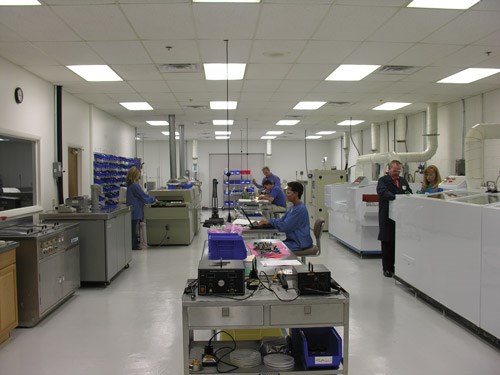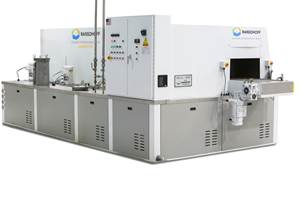Choosing an Aqueous Parts Washing System
As machining technology has advanced, expectations for product quality have increased as well.
As machining technology has advanced, expectations for product quality have increased as well. But better finishes and tighter tolerances are not the only goals. The need for meeting more stringent cleaning standards has gained the attention of many shops. But these shops, while experts at metal removal, often are not knowledgeable about the best methods for cleaning their parts. So they often turn to outside sources for selecting their cleaning processes.
First Steps
The first step in choosing any cleaning system should start right at home with understanding the soil to be removed and the parts from which that soil needs to be removed. After all, the working definition of cleaning is removing an undesired contaminant from a desired substrate. How clean do the parts need to be, and what is the measure of cleanliness? Often, another important consideration is the need to protect the parts from corrosion. These key elements must be understood before further decisions can be effective.
The initial steps of this analysis will already put a shop ahead of the pack. It is then time to determine a cleaning material that will remove the soil without damaging the parts. But how can this determination be made without a cleaning machine on the floor to test with? This is where suppliers come in—those area experts who have their own laboratories with cleaning equipment to generate the necessary data to effectively narrow the choices. A shop might already have a supplier that can fulfill this purpose, or they can be found at trade shows or in supplier directories such as at productionmachining.com.
Gathering Data
The test data will reveal several important facts about what cleaning technology was effective at removing the soil from the parts and the process conditions that were most effective with that cleaning technology. Specific information can be gathered about temperature, operating concentration (for aqueous processes), the mechanical energy (sprays, ultrasonics, and so on) and most importantly, the length of time required for effective cleaning.
Other concerns may arise about the cleaning chemistry itself. Most applications will not require harsh materials, so hazardous, corrosive products should be avoided if possible. Modern cleaning products have become much safer, both for people and the environment. Material safety data sheets (MSDS) should be reviewed, and anything that is unclear should be addressed with the supplier. If EH&S professionals are on staff, they should be included in this process.
When the cleaned parts have been returned by the supplier for evaluation, they should be subjected to the shop’s existing QC process as well as downstream processing such as coating. If the final product meets the necessary standards and the shop is comfortable with the cleaning materials and process recommendations, it is time to consider equipment.
Equipment Selection
The first step in determining the equipment to be used in the cleaning process is to see what existing equipment in the shop may be able to deliver the process conditions that the materials supplier has recommended. Even if the appropriate equipment is in place, it needs to be evaluated for capacity and performance as well to determine if the current production requirements leave enough idle capacity to handle the new project and if it will perform as expected. Cleaning chemistry suppliers typically will assist in on-site cleaning trials for this evaluation process. If the existing cleaning equipment meets the shop’s needs, the new process can be implemented. But if no slack remains in the process equipment capabilities, it’s time to shop for additional equipment.
Trade fairs such as IMTS, FabTech, the Process Cleaning Expo and even Parts2Clean in Stuttgart, Germany, are well attended, particularly by cleaning equipment manufacturers. If timing or travel budgets prohibit show attendance, a Google search for “industrial parts washers” provides more than a million resources. But to narrow the list to something more manageable, supplier directories from trade shows or productionmachining.com may be the most practical resource.
The data provided free of charge by the materials supplier will most likely spell out the necessary process capabilities. Only the shop itself, though, knows the details about product throughput: How many parts per minute or hour are being produced? Are the parts made in lots and contained in baskets or handled singly? Do the parts require special handling or custom fixturing? Is drying critical (such as with ferrous parts)?
Some part shapes require specific positioning to limit the loss of cleaning material during the process. Screw machine parts are often cleaned in packed basket loads. By considering handling requirements such as these, along with process parameters such as throughput, the first key determination—batch or conveyor system—can be made.
After narrowing the list of equipment suppliers, it’s time to begin the evaluation process again. But this time, the informed shop knows the type of process and process conditions that will deliver a clean part because the materials suppliers provided cleaned parts that passed the QC process. The equipment manufacturers can be informed of the appropriate process parameters and cleaning materials and apply them to a range of machines to allow an even comparison. All of the test parts from the equipment manufacturers should also go through the shop’s standard QC evaluation.
Good to Go
After completing this sophisticated development and evaluation of the cleaning process, including studying the data and evaluating the value proposition from each candidate supplier, a well informed decision can be made. While waiting for the machine to be delivered, the shop can get a head start on the facility requirements to simplify the installation. Items of concern might include power drops, water, drains, waste permits and any necessary dedicated handling equipment.
The material and equipment suppliers should be invited to the installation and startup, as their expertise can be very beneficial. After startup, the materials supplier should be expected to provide additional technical support for the cleaning process, helping with process optimization and operator training.
It’s time to produce, ship and invoice those new, clean, high value parts.
Related Content
3 Common Filtration Questions Answered
Learn about the variety of filters for removing particulates from a cleaning fluid, how to determine cleaning fluid life and more.
Read MoreVersatile Sandblasting for Deburring Intricate Geometries
PMTS 2023: Comco’s MicroBlasting sandblasting systems can deburr, texture and clean small, intricate parts.
Read MorePMTS 2023 Product Preview: Parts Cleaning
Learn about some of the latest parts cleaning solutions that will be on display at PMTS 2023.
Read MoreCool Clean’s Omega 1500 Provides Powerful, Portable Cleaning
PMTS 2023: By selecting the appropriate nozzle and making the necessary propellant pressure and temperature adjustments, the Omega 1500 can clean to a variety of surface cleanliness levels.
Read MoreRead Next
Aqueous Cleaning for Aerospace
A turbine manufacturing plant phases out an obsolete vapor degreasing system, making the change to aqueous-based cleaning.
Read MoreEmerging Leaders Nominations Now Open
Here’s your chance to highlight a young person in your manufacturing business who is on the path to be a future leader moving your company forward.
Read MoreA Tooling Workshop Worth a Visit
Marubeni Citizen-Cincom’s tooling and accessory workshop offers a chance to learn more about ancillary devices that can boost machining efficiency and capability.
Read More























